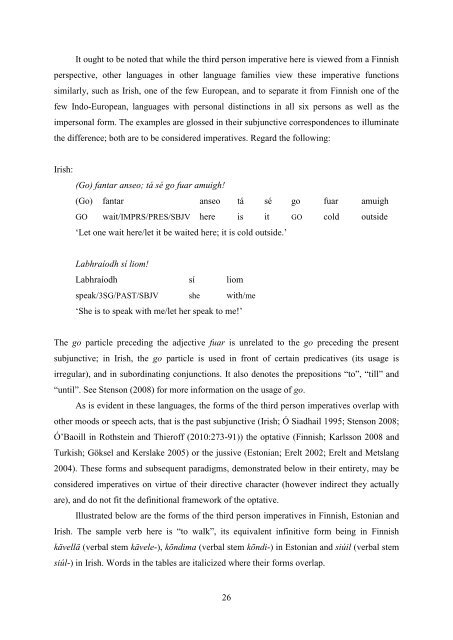The function of non-canonical imperatives in the languages of Europe
The function of non-canonical imperatives in the languages of Europe
The function of non-canonical imperatives in the languages of Europe
Create successful ePaper yourself
Turn your PDF publications into a flip-book with our unique Google optimized e-Paper software.
It ought to be noted that while <strong>the</strong> third person imperative here is viewed from a F<strong>in</strong>nish<br />
perspective, o<strong>the</strong>r <strong>languages</strong> <strong>in</strong> o<strong>the</strong>r language families view <strong>the</strong>se imperative <strong>function</strong>s<br />
similarly, such as Irish, one <strong>of</strong> <strong>the</strong> few <strong>Europe</strong>an, and to separate it from F<strong>in</strong>nish one <strong>of</strong> <strong>the</strong><br />
few Indo-<strong>Europe</strong>an, <strong>languages</strong> with personal dist<strong>in</strong>ctions <strong>in</strong> all six persons as well as <strong>the</strong><br />
impersonal form. <strong>The</strong> examples are glossed <strong>in</strong> <strong>the</strong>ir subjunctive correspondences to illum<strong>in</strong>ate<br />
<strong>the</strong> difference; both are to be considered <strong>imperatives</strong>. Regard <strong>the</strong> follow<strong>in</strong>g:<br />
Irish:<br />
(Go) fantar anseo; tá sé go fuar amuigh!<br />
(Go) fantar anseo tá sé go fuar amuigh<br />
GO wait/IMPRS/PRES/SBJV here is it GO cold outside<br />
‘Let one wait here/let it be waited here; it is cold outside.’<br />
Labhraíodh sí liom!<br />
Labhraíodh sí liom<br />
speak/3SG/PAST/SBJV she with/me<br />
‘She is to speak with me/let her speak to me!’<br />
<strong>The</strong> go particle preced<strong>in</strong>g <strong>the</strong> adjective fuar is unrelated to <strong>the</strong> go preced<strong>in</strong>g <strong>the</strong> present<br />
subjunctive; <strong>in</strong> Irish, <strong>the</strong> go particle is used <strong>in</strong> front <strong>of</strong> certa<strong>in</strong> predicatives (its usage is<br />
irregular), and <strong>in</strong> subord<strong>in</strong>at<strong>in</strong>g conjunctions. It also denotes <strong>the</strong> prepositions “to”, “till” and<br />
“until”. See Stenson (2008) for more <strong>in</strong>formation on <strong>the</strong> usage <strong>of</strong> go.<br />
As is evident <strong>in</strong> <strong>the</strong>se <strong>languages</strong>, <strong>the</strong> forms <strong>of</strong> <strong>the</strong> third person <strong>imperatives</strong> overlap with<br />
o<strong>the</strong>r moods or speech acts, that is <strong>the</strong> past subjunctive (Irish; Ó Siadhail 1995; Stenson 2008;<br />
Ó’Baoill <strong>in</strong> Rothste<strong>in</strong> and Thier<strong>of</strong>f (2010:273-91)) <strong>the</strong> optative (F<strong>in</strong>nish; Karlsson 2008 and<br />
Turkish; Göksel and Kerslake 2005) or <strong>the</strong> jussive (Estonian; Erelt 2002; Erelt and Metslang<br />
2004). <strong>The</strong>se forms and subsequent paradigms, demonstrated below <strong>in</strong> <strong>the</strong>ir entirety, may be<br />
considered <strong>imperatives</strong> on virtue <strong>of</strong> <strong>the</strong>ir directive character (however <strong>in</strong>direct <strong>the</strong>y actually<br />
are), and do not fit <strong>the</strong> def<strong>in</strong>itional framework <strong>of</strong> <strong>the</strong> optative.<br />
Illustrated below are <strong>the</strong> forms <strong>of</strong> <strong>the</strong> third person <strong>imperatives</strong> <strong>in</strong> F<strong>in</strong>nish, Estonian and<br />
Irish. <strong>The</strong> sample verb here is “to walk”, its equivalent <strong>in</strong>f<strong>in</strong>itive form be<strong>in</strong>g <strong>in</strong> F<strong>in</strong>nish<br />
kävellä (verbal stem kävele-), kõndima (verbal stem kõndi-) <strong>in</strong> Estonian and siúil (verbal stem<br />
siúl-) <strong>in</strong> Irish. Words <strong>in</strong> <strong>the</strong> tables are italicized where <strong>the</strong>ir forms overlap.<br />
26
















